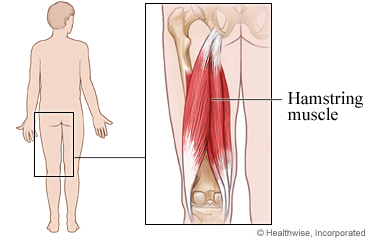Hamstring Syndrome: Care Instructions
Overview

The hamstring muscles are the three muscles in the back of the thigh. The sciatic nerve is a large nerve that
runs from the low back down the legs. Hamstring syndrome is a condition caused by pressure on this nerve. The
nerve may be pinched between the hamstring muscles and the pelvic bone or by the band of tissue that connects
the hamstring muscles.
This condition can cause pain in the hip and buttock and sometimes numbness down the back of the leg. It may
hurt to sit down or stretch the hamstrings. You may have less pain when you lie on your back.
Hamstring syndrome may be the result of wear and tear to the back and hamstrings. It is most often seen in
people who play sports that involve running, kicking, or jumping.
Other problems can cause leg pain and numbness. To diagnose hamstring syndrome, the doctor will ask about
your symptoms and your activities and examine your leg.
Hamstring syndrome usually gets better in a few weeks with rest and home care. The doctor may recommend
exercises to stretch and strengthen your hip muscles. If home care doesn't help, your doctor may suggest a
steroid shot to help reduce pain and swelling.
Follow-up care is a key part of your treatment and safety. Be sure to make and go to all
appointments, and call your doctor if you are having problems. It's also a good idea to know your test results
and keep a list of the medicines you take.
How can you care for yourself at home?
-
Ask your doctor if you can take an over-the-counter pain medicine, such as acetaminophen (Tylenol),
ibuprofen (Advil, Motrin), or naproxen (Aleve). Be safe with medicines. Read and follow all instructions on
the label.
-
Put ice or a cold pack on the painful area for 10 to 20 minutes at a time. Try to do this every 1 to 2
hours for the next 3 days (when you are awake). Put a thin cloth between the ice and your skin.
-
After 2 or 3 days, apply heat. Put a warm water bottle, a heating pad set on low, or a warm cloth over the
painful area. Do not go to sleep with a heating pad on your skin.
-
Avoid sitting if possible, unless it feels better than standing.
-
Alternate lying down with short walks. Increase your walking distance as you are able to walk without
making your symptoms worse.
-
Don't do anything that makes your symptoms worse. Return to your usual level of activity slowly.
When should you call for help?
 Watch closely
for changes in your health, and be sure to contact your doctor if:
Watch closely
for changes in your health, and be sure to contact your doctor if:
Current as of: December 20, 2023
Content Version: 14.0
Care instructions adapted under license by your
healthcare professional. If you have questions about a medical condition or this instruction, always ask
your healthcare professional. Healthwise, Incorporated disclaims any warranty or liability for your use of
this information.